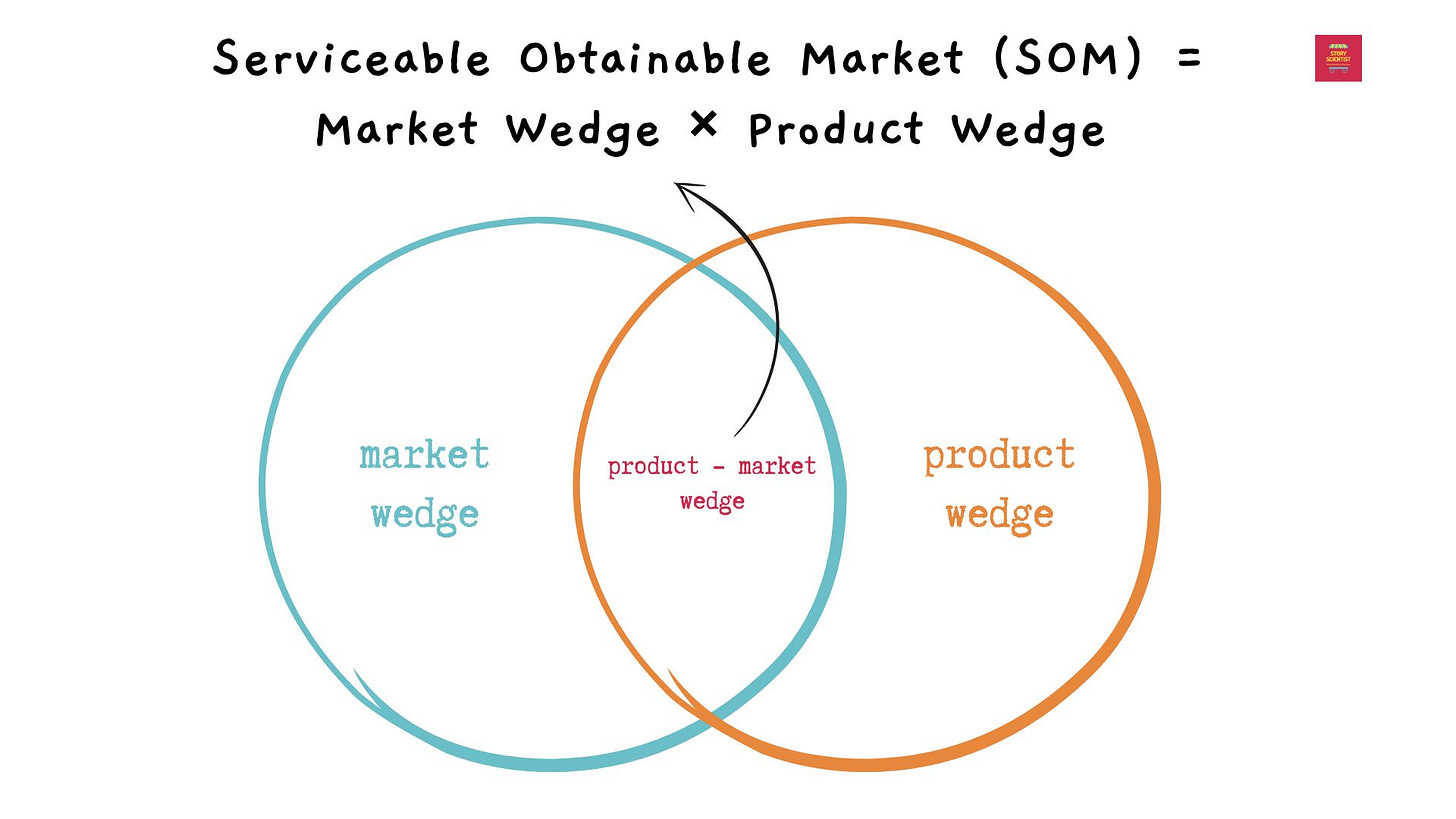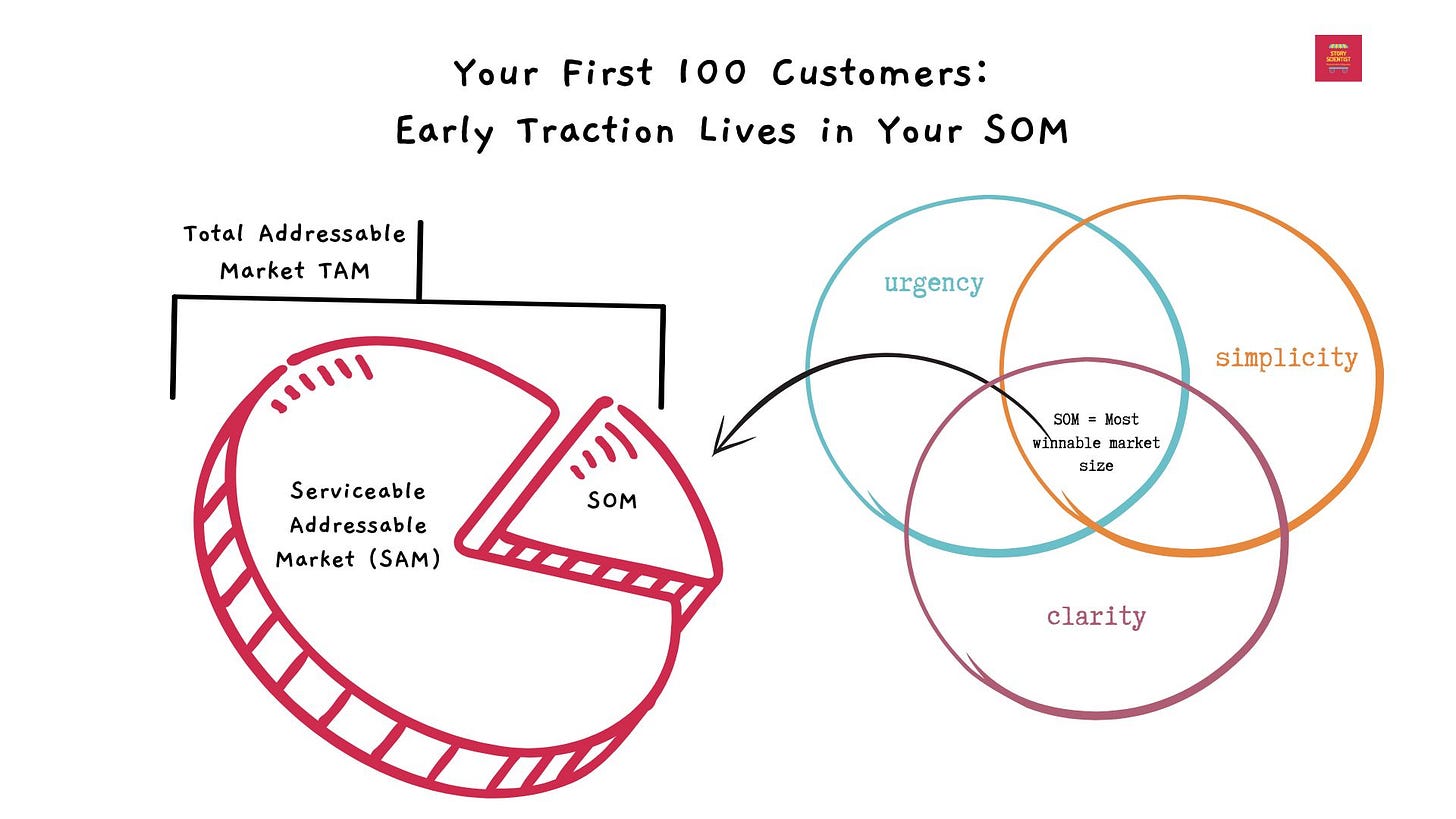How to Know Who Should Be Your Early Adopters
Finding the Beachhead Segment That Gives You the Wedge
Every founder is told to “go after your TAM.” Is that the starting point?
You don’t win a market by starting with the market. You win by starting with one small, sharp wedge that opens the door. That wedge is your SOM — your Serviceable Obtainable Market.
And your early adopters are hiding inside it.
Your first 100 customers
TAM vs SAM vs SOM: Why SOM = Your Wedge
Let’s break this down:
Layer What It Means Relevance TAM Total Addressable Market The full universe of possible customers SAM Serviceable Available Market Those who can use your product with its current capabilities SOM Serviceable Obtainable Market Those you can actually reach, serve, and convert today
👉 TAM tells a great story to investors.
👉 SAM helps you scope features and pricing.
👉 But SOM is what gets you traction.
So What Is SOM, Really?
SOM = Market Wedge × Product Wedge
Let’s break those down:
Step 1: What Makes a Great Beachhead Segment?
Now that we’ve defined SOM as your wedge, how do you pick the right segment to focus on?
Ask: Does this segment…
Experience the pain clearly and frequently?
Feel small enough to dominate, not just test?
Convert fast with clear buying signals?
Act as a springboard to adjacent verticals later?
A great beachhead customer:
Needs your solution now
Has few decent alternatives
Closes quickly
Refers others like them
Narrow is not a weakness. Narrow is how you get repeatability.
Step 2: Use the “Size × Need × Speed to Close” Formula
Here’s a quick scoring system to help you prioritize segments:
Each metric is scored on a 1–5 scale:
ICP Score = Size × Need × Speed
Use this score as a directional filter, not a final decision.
Step 3: Explore Wedges
The Market Wedge
Your market wedge is the sharpest, most reachable slice of the market where:
A clear and painful problem exists
There's urgency to act
You already have access or credibility
Decision-making is fast and informal
Word-of-mouth can take off quickly
Example: Instead of “all HR teams,” go after “2–10 person recruiting agencies in India with under 50K monthly budget and manual workflows.”
This wedge is defined not by who wants your product, but by who can’t afford to wait.
Instead of:
“We’re building for B2B sales teams across industries.”
Refine to:
“Outbound sales leaders at 5–25 person B2B SaaS startups in India, who are still using spreadsheets to track deal stages and facing high SDR churn.”
The Product Wedge
Your product wedge is the subset of your capabilities that:
Solves one specific painful job
Doesn’t require feature bloat or customization
Can be delivered fast and show value within days/weeks
Has a sharp message that resonates deeply with a niche
Example: Instead of “full-stack analytics platform,” pitch “auto-detection of revenue leaks for Shopify stores in 7 days.”
You don’t need a full-suite product to win early.
You need a wedge that works fast and hits hard.
Instead of:
“A full sales CRM platform with automations, analytics, and integrations.”
Refine to:
“A plug-and-play Kanban CRM with SDR accountability insights that replaces spreadsheets in 30 minutes — no onboarding required.”
3. Where They Meet: SOM
When the market wedge overlaps with your product wedge, you get your SOM:
The sharpest, most viable customer segment +
The most focused, compelling solution =
Your Serviceable Obtainable Market
When you bring them together:
Serviceable Obtainable Market =
Outbound sales leaders at early-stage Indian B2B SaaS companies who urgently want to clean up pipeline chaos
+
A fast-install CRM that replaces spreadsheets with SDR performance visibility in under an hour
This is your wedge. You can win this segment now, with what you already have.
SOM is not who you could serve.
It’s who you can win right now.
This is your wedge and it unlocks everything else.
STEP 4: Use the Value-Density Matrix to Validate
Layer in another diagnostic: the Value-Density Matrix.
Your goal:
✅ Find high-value, low-effort customers in your wedge.
❌ Avoid high-effort, low-return “shiny” segments.
Watch Out for Over-Indexing
A common trap: chasing what looks exciting instead of what closes.
Examples of over-indexing:
Targeting big brands too early for credibility
Building for power users who don’t pay
Writing content for audiences who don’t convert
These signals feel promising, but don’t compound results.
Stay focused on value-dense, fast-converting users
Validate enthusiasm with behavior AND not flattery
Action Plan: Find and Test Your Wedge
Here’s a 6-step plan to lock in your beachhead:
List 2–3 candidate segments
Score them using Size × Need × Speed
Determine a few wedges to explore
Use the Value-Density Matrix for second-order signals
Create 3 narratives per segment, test on:
LinkedIn
Cold outreach
Landing pages
Track results:
Time to first response
Time to close
Retention / expansion signals
Your Early Traction Lives in Your SOM
Your SOM is not just a spreadsheet number. It’s the intersection of urgency, simplicity, and clarity.
It’s where your sharpest product slice meets your most winnable market slice.
Don’t chase the full market. Wedge into it.
Traction isn’t about building more. It’s about choosing better.










You summarised what I learnt in 2 years into a single post 🔥